How To Repair Outside Irrigation Watering Valve

The spider web's female parent lode of free irrigation information!
How to Repair a Irrigation Solenoid Valve
When a solenoid valve (also called an electrical valve or automatic sprinkler valve) fails to shut information technology is almost e'er because something is stuck inside information technology. This might be a grain of sand, a small twig, a insect, or even a tiny snail. To ready the valve you need to disassemble and clean it. When a valve fails to open information technology is unremarkably due to a bad solenoid or bad wiring, although in rare cases a grain of sand stuck inside the valve or a ripped diaphragm inside the valve. The following instruction tell how to disassemble, clean, and audit the automatic valve.
To clean the valve:
Equally you disassemble the valve exist certain to note how all the parts fit together so you tin can become it back together correctly! I strongly advise you make a sketch and take notes. Each make and model of valve is slightly different. The valve shown in the photos here is an anti-siphon type valve, which is a type usually used on domicile sprinkler systems. The cap structure on the right side of this valve is the anti-siphon device.
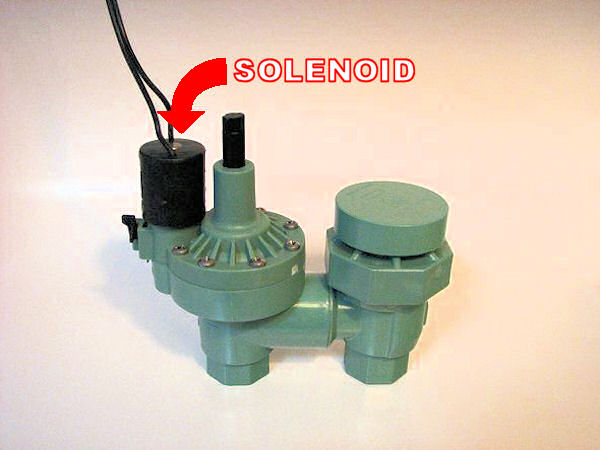
Typical Anti-Siphon Blazon Solenoid Valve
Remove the solenoid from the valve. Well-nigh solenoids unscrew counter-clockwise to remove. When removing the solenoid watch that the spring loaded plunger within it does not pop-out and fall into a mud puddle. On most newer valves the plunger is held "convict" and then information technology won't fall out when the solenoid is removed, but sometimes even those ones come up loose. Once the solenoid is removed, push in on the end of the leap-loaded plunger in the solenoid. It should jump gently back out when released, and it should slide in and out smoothly when pressed several times in a row. If the plunger doesn't motility easily and smoothly, supersede the solenoid; it is damaged and tin't be repaired. Do not apply whatever oil or lubricant to the solenoid plunger, if it is sticking it is not repairable, replace information technology.
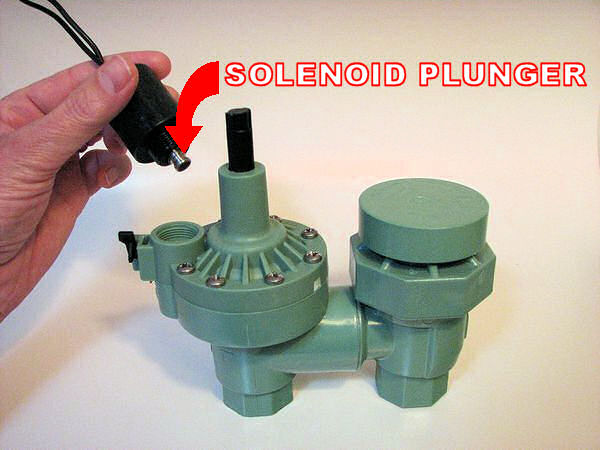
Solenoid Removed, Showing Plunger
Remove the valve lid, about are held in identify past several metallic screws. Some models of valve have lids that spiral off like the top of a jar, plough counter-clockwise (lefty losey) to remove this type of chapeau. You may demand to utilize a strap wrench to remove the jar-superlative style lids. All valves have a spring nether the lid, don't allow information technology fall out into the mud! Remove the bound and gear up it aside.
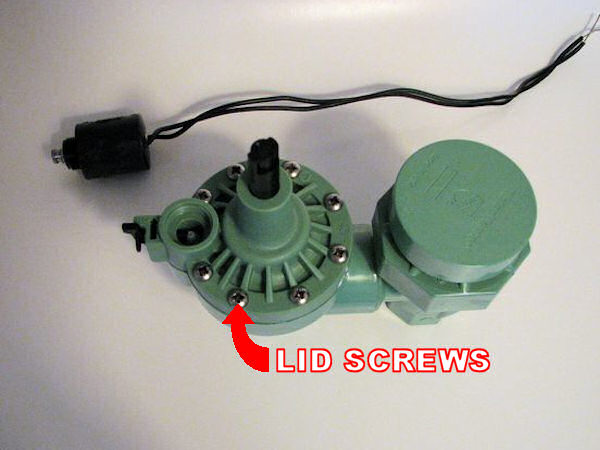
Valve Lid Screws
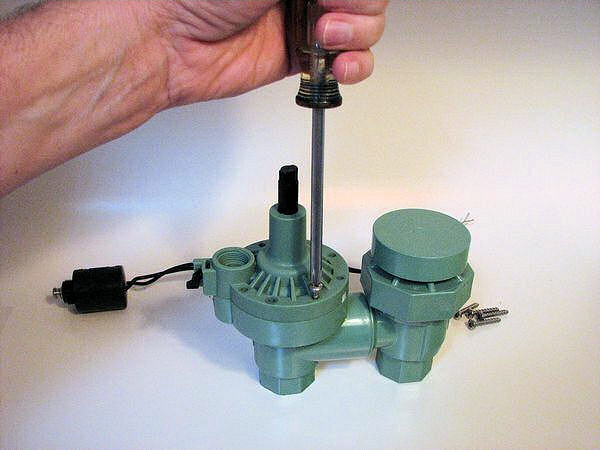
Removing Valve Chapeau Screws
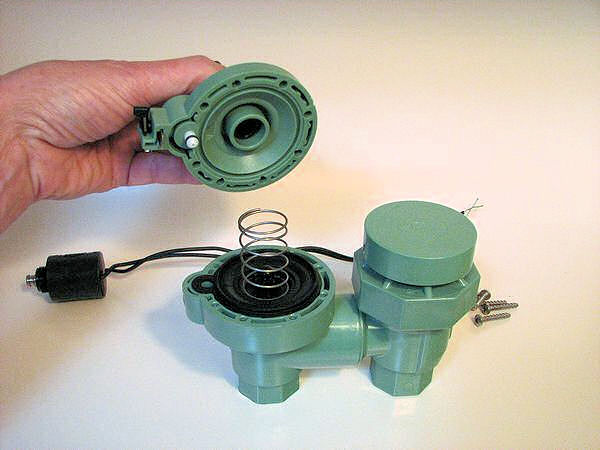
Watch that the Bound Does Non Fall Out When Removing the Chapeau
Look for the tiny passages, called "ports", inside the valve lid. These ports lead from the lesser of the lid to the surface area where the solenoid was attached. The exact location of the ports varies with each valve make and model. Make sure these passages are not clogged with a grain of sand or whatever. Be careful you do not scratch or overstate these passages when trying to get the sand out! Practice not endeavour to drill out these ports to clean them or make them larger.
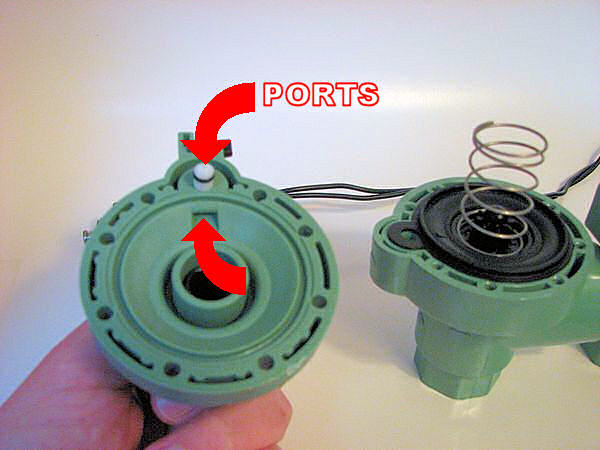
Ports in Lid
Remove the rubber diaphragm from the valve. Brand sure it is not croaky or broken, if it is replace it. Some valve models besides accept a port in the diaphragm, check to see if there is ane, if and then make certain it is clean. On some valves the port in the diaphragm has a metal pin that runs through it, the purpose of the pin is to keep the port make clean. The pin should slide freely in the port. The diaphragm in the photo below has a separate, removable seat gasket attached to the lesser of it with a screw. On many valves the safety seat gasket and the diaphragm are ane slice and the seat gasket is not removable. Make certain the seat gasket or diaphragm seat does not have annihilation stuck on information technology, similar a grain of sand or twig. If the gasket surface is scratched or torn replace the gasket or diaphragm.
Examine the valve seat in the bottom of the valve body. The seat is the role of the valve trunk that the gasket presses against to terminate the water flow through the valve. Brand sure the seat is not scratched or pitted, if it is the valve will leak when closed. On some valves the seat is replaceable. On some brass valves the seat tin can exist ground down with a special tool to remove pits and scratches. Nonetheless, for near valves if the seat is scratched or pitted, the valve is not repairable and must be replaced.
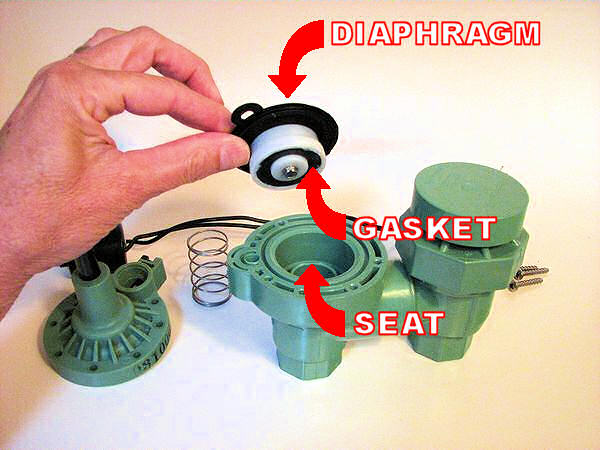
Rubber Diaphragm and Gasket
With the valve disassembled turn on the water to flush whatever remaining sand and crud from the pipes upstream of the valve. Plow it on full blast, and run it for a minute or two, you demand to get everything out of that pipe. Plough off the water, and dry out yourself off. I know y'all don't want to get wet, but don't skip flushing the pipes and valve body, this is an important stride!
Advisedly make clean everything, so reassemble the valve. Some valves have a carve up lid gasket or o-ring that needs to be cleaned or replaced before being reassembled. If there are any o-rings, I strongly suggest y'all lubricate them before reassembling using K-Y Jelly or a similar product. Lubricating o-rings is optional, but recommended as it keeps them from crimping during assembly. If the o-ring crimps it will be ruined and will leak. K-Y Jelly is a h2o-based lubricant that yous buy in the feminine hygiene department of a supermarket or drug store. (Don't ask for it at the hardware store unless you want to give the employees a skillful laugh at your expense. Yes, I admit I fell for this back when I was starting time starting out in this concern, information technology's a favorite plumber gag to send the new guy out to buy the K-Y Jelly!) Practice not use vaseline, silicone, oil or whatsoever petroleum based products on the valve, they may damage the seals and besides may clog the ports in the valve.
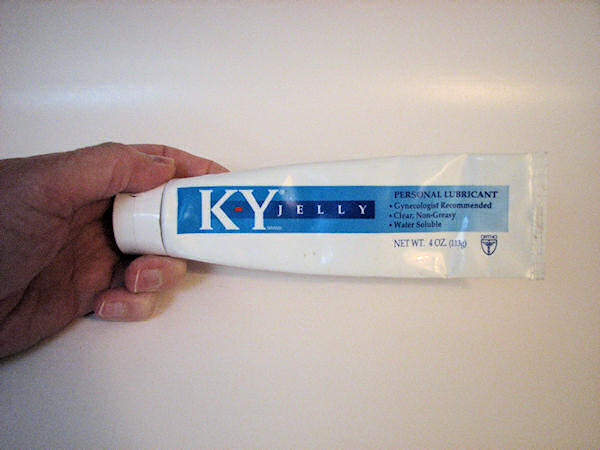
Use Thousand-Y Jelly to Lubricate Rubber Parts of the Valve
Do Not Use Petroleum-Based Products!
When attaching the lid, avoid striping out the chapeau threads and warping the lid equally follows: When inserting the screws that hold the cap on, start with one of the screws side by side to the solenoid. Insert the screw in the pigsty and then turn it counter-clockwise (losey lefty) until you experience a slight click as the screw finds the threads. So reverse direction (righty tighty) and lightly tighten it. So insert the 2nd screw on the reverse side of the valve lid. Like the first, observe the threads and so just lightly tighten the screw. Keep with one spiral on one side and the next on the other until they are all in. Now become dorsum and tighten them all, going in the same social club you inserted them. Practice not over-tighten the screws on plastic valves, you lot volition strip out the threads.
If you're blest and didn't mess upwards something the valve should work correctly now.
Suggestion: Your valve has already failed once, chances are that means something in the water got stuck in it, which ways there is sand or whatever in the water supply. Consider installing a filter upstream of the valve to keep out the sand and crud in the hereafter. Typically the cost of a valve repair is greater than the cost of installing a filter. See the Irrigation Water Filtration Tutorial.
Text and Images past Jess Stryker unless noted. Copyright © Jess Stryker, 1997-2018. All rights reserved.
Source: https://www.irrigationtutorials.com/faq/repair-valve.htm
Posted by: colepliteard.blogspot.com



0 Response to "How To Repair Outside Irrigation Watering Valve"
Post a Comment